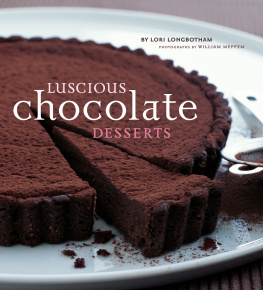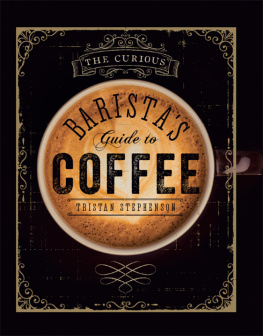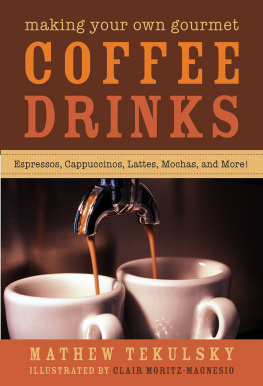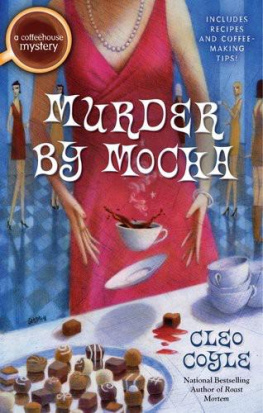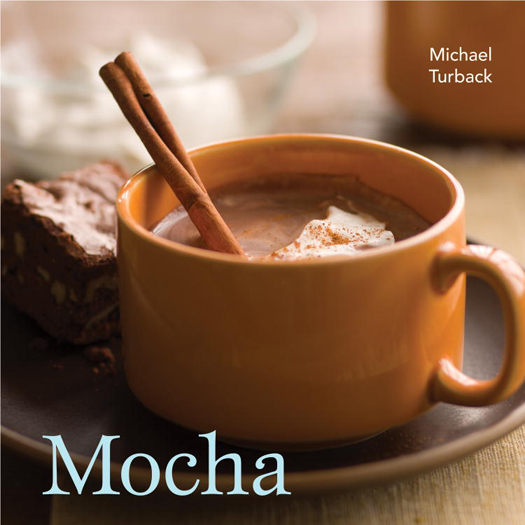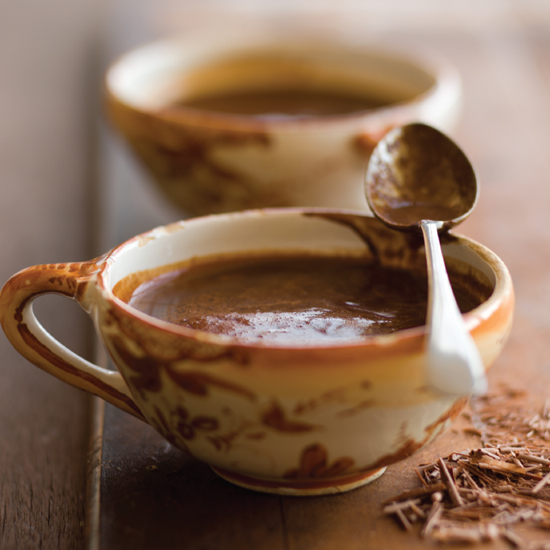Copyright 2007 by Michael Turback.
Cover and interior photographs Copyright 2007 by Leo Gong
All rights reserved.
Published in the United States by Ten Speed Press, an imprint of the Crown Publishing Croup, a division of Random House, Inc., New York.
www.crownpublishing.com
www.tenspeed.com
Ten Speed Press and the Ten Speed Press colophon are registered trademarks of Random House, Inc.
Cover design by Betsy Stromberg and Katy Brown
Food and props styled by Karen Shinto
Photo assistants Akiko Seki and Harumi Seki
Library of Congress Cataloging-in-Publication Data
Turback, Michael.
Mocha / Michael Turback ; photography by Leo Gong.
p. cm.
Includes index.
ISBN-13: 978-1-58008-861-9 (alk. paper)
ISBN-10: 1-58008-861-9 (alk. paper)
1. Cookery (Chocolate) 2. Cookery (Coffee) I. Title. II. Title: Chocolate and coffee.
TX767.C5T87 2007
641.3374dc22
eBook ISBN: 9780307762269
Trade paperback ISBN: 9781580088619
v3.1
Contents
For Vic & Winnie
Acknowledgments
This book was written with the help of a great many people who contributed their energies to the project. I would like to start with a special acknowledgment for the support of my wife Juliet, who patiently put up with my late-night and weekend writing activities and who kept me excited about the project.
I was honored to have the blessing and guidance of Andrea Slitti, the celebrated Tuscan chocolatier and coffee roaster, a man who will tell you that the voluptuous combination of chocolate and coffee is why God invented eating.
My thanks go in full measure to the generous efforts and inventive recipes contributed by some of the planets best chocolatiers, pastry chefs, and baristas. This book is a tribute to their passions.
Thanks, too, for wisdom and support from Fortune Elkins, Sherri Johns, Shelly Burgess, Britt Figueroa, Michael Szyliowicz, Brian Martell, Anil Rohira, Rogerio David, Peter ODonnell, Barbara Lang, and, of course, very special thanks to Meryl Davis and Marjorie Rugg, my chief assistants in the preparation of this volume.
It has once again been a pleasure to work with the fabulously talented people at Ten Speed Press, in particular, Veronica Randall, my editor. I must extend a very special appreciation to Dennis Hayes, adventurer and friend. This book would not have been possible without his enthusiasm and energy.
Some of the material in this book was inspired by conversations, email, and advice from colleagues in the hospitality industry. I have credited these sources where known, but if I have overlooked anyone, please accept my apologies with my thanks.
Finally, I want to acknowledge the most important people in the life of this bookthe readers. Thank you!
Chocolate & Coffee:
MUTUAL ATTRACTION
Although seemingly contradictory in their culinary natures, chocolate and coffee have more in common than they have differences. Both ingredients, derived from roasted beans grown in tropical and subtropical regions, are synonymous with sensory delight and noble thoughts, their incorporation into modern culture preceded by centuries of mythology and tradition.
Mature cacao trees produce pods the size of a human hand, and inside these fruits are the trees seeds, known as cocoa beans to the trade. The less statuesque coffee tree produces berries the color and size of small cherries. Inside the skin and pulp are nestled twin coffee beans, flat sides facing each other.
Although worlds apart in origin and genealogy, chocolate and coffee eventually came to share some of the same geography. The coffee tree, native to Africa, was first cultivated in the Ethiopian province of Kaffa, giving the drink its name. By the eighteenth century, Jesuit missionaries from Spain and Portugal had transplanted African coffee into South America, where the volcanic soil of the Andes Mountains, along with mild temperatures and abundant rainfall, enabled the new crop to flourish. Today, Brazil and Columbia produce most of the planets coffee.
The journey of chocolate was just the reverse. Native cacao from Mexico, Costa Rica, and Venezuela supplied Europe and the Americas with chocolate until the nineteenth century when the Dutch introduced New World cacao to the Gold Coast of West Africa. And today, as fate would have it, the African nations of Ghana and Nigeria have become the leading growers of cacao.
The smell of hot chocolate on a cold day is a great temporary panacea for most any troubles.
BRIAN LUKE SEAWARD,
THE ART OF CALM
As with wine grapes, the totality of environment or terroir proves critical to the development of specific flavor notes within both cacao and coffee beans. A singular variety often dominates in each specific latitude and growing region, imparting an expected taste profile uniquely characteristic of those beans. Coffee beans from the rich volcanic soils in the highlands of Kenya are usually roasted lightly so their signature body, acidity, and blackcurrant flavors are preserved. Chuao, a small village in the northern coastal range of Venezuela, shielded by mountains from all but the warm Caribbean breezes, is home to distinctive, assertive cacao with undertones of exotic fruits and traces of vanilla.
While the blending of cacao beans, and the blending of coffee beans, are considered art forms, ensuring quality and consistency, there is steady movement toward single-origin chocolates and coffees, derived from only one type of bean from a specific locale. These unblended, appellation-specific products capture the pure essence of beans grown and harvested from a single farm or estate, much to the delight of sophisticated palates everywhere.
Throughout early coffee history, Arab traders held a monopoly on the exportation of the precious beans from the port of Mocha in southwestern Yemen on the Red Sea. At one time the name mocha was synonymous with coffee, yet the term has become somewhat ambiguous. On the palate, roasted native Mocha beans exhibit distinct chocolatey notes, and for that reason, legend persists, the same term is used to describe the marriage of coffee and chocolate.
No coffee can be good in the mouth that does not first send a sweet offering of odour to the nostrils.
HENRY WARD BEECHER
As sixteenth-century sailing ships carried goods from the Arabian Peninsula across the Mediterranean, the Italian port of Venice became coffees gateway to European markets. Merchants in Venice and Turin opened the earliest coffee houses, and when Spanish drinking chocolate was first introduced to Turin, it was mixed with coffee and cream into a stimulating novelty called bavareisa.





